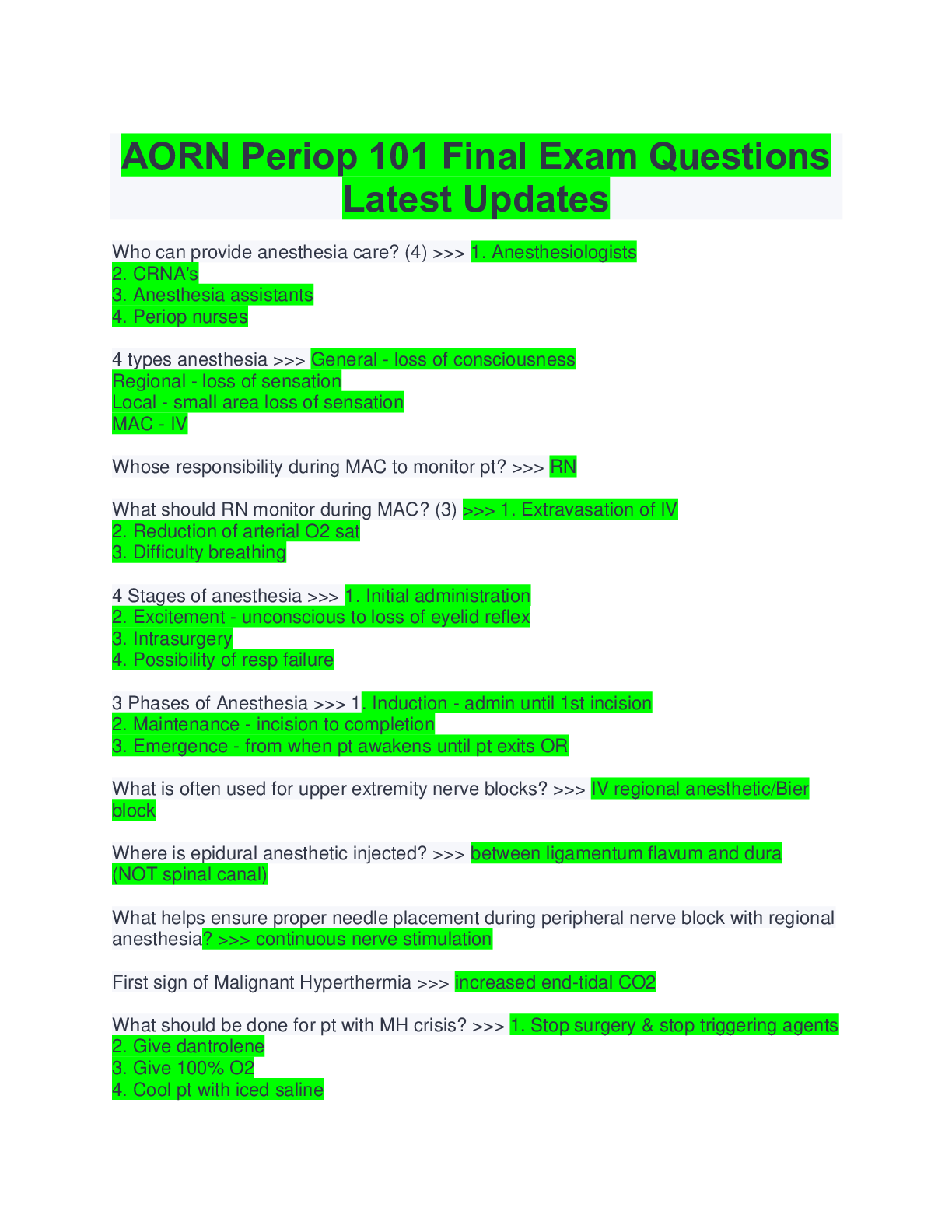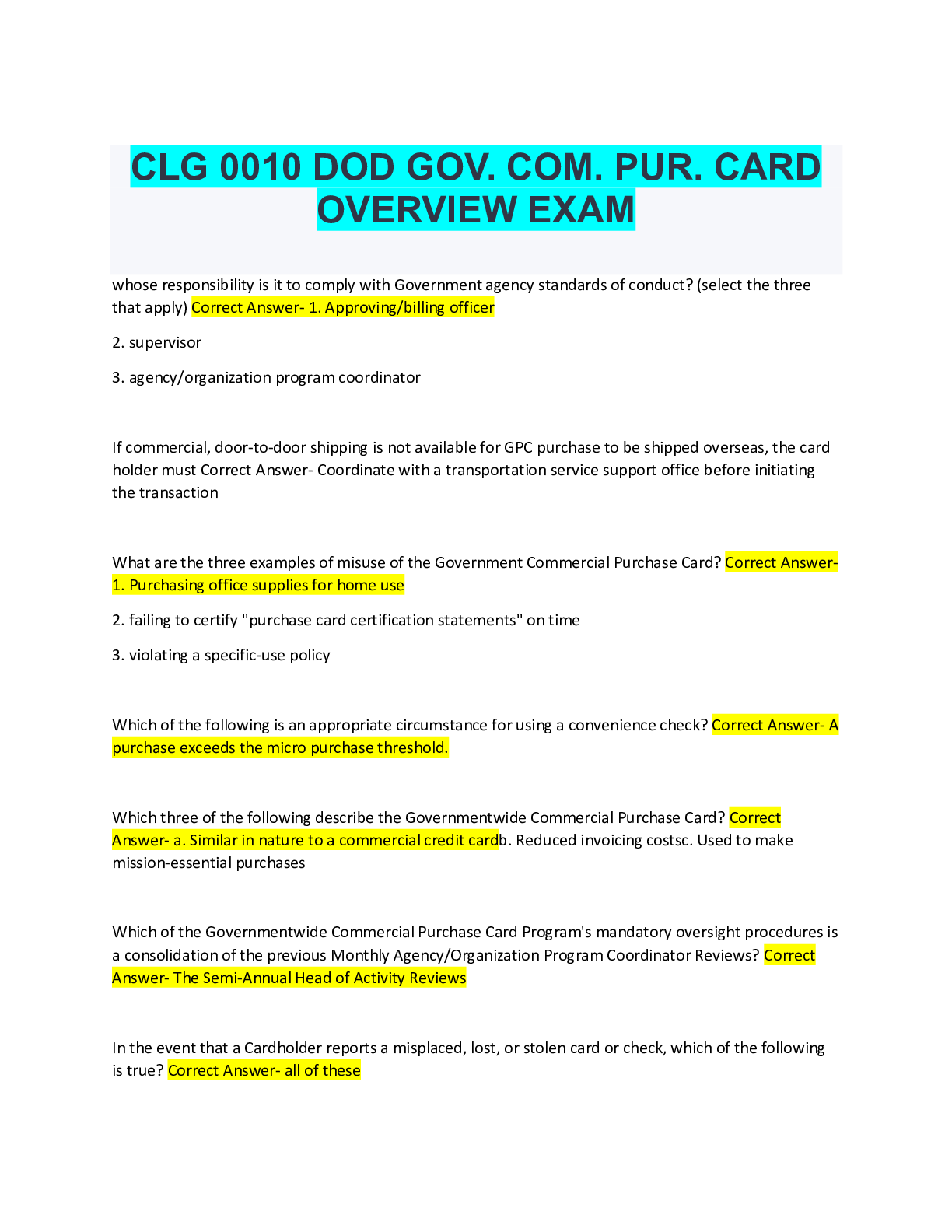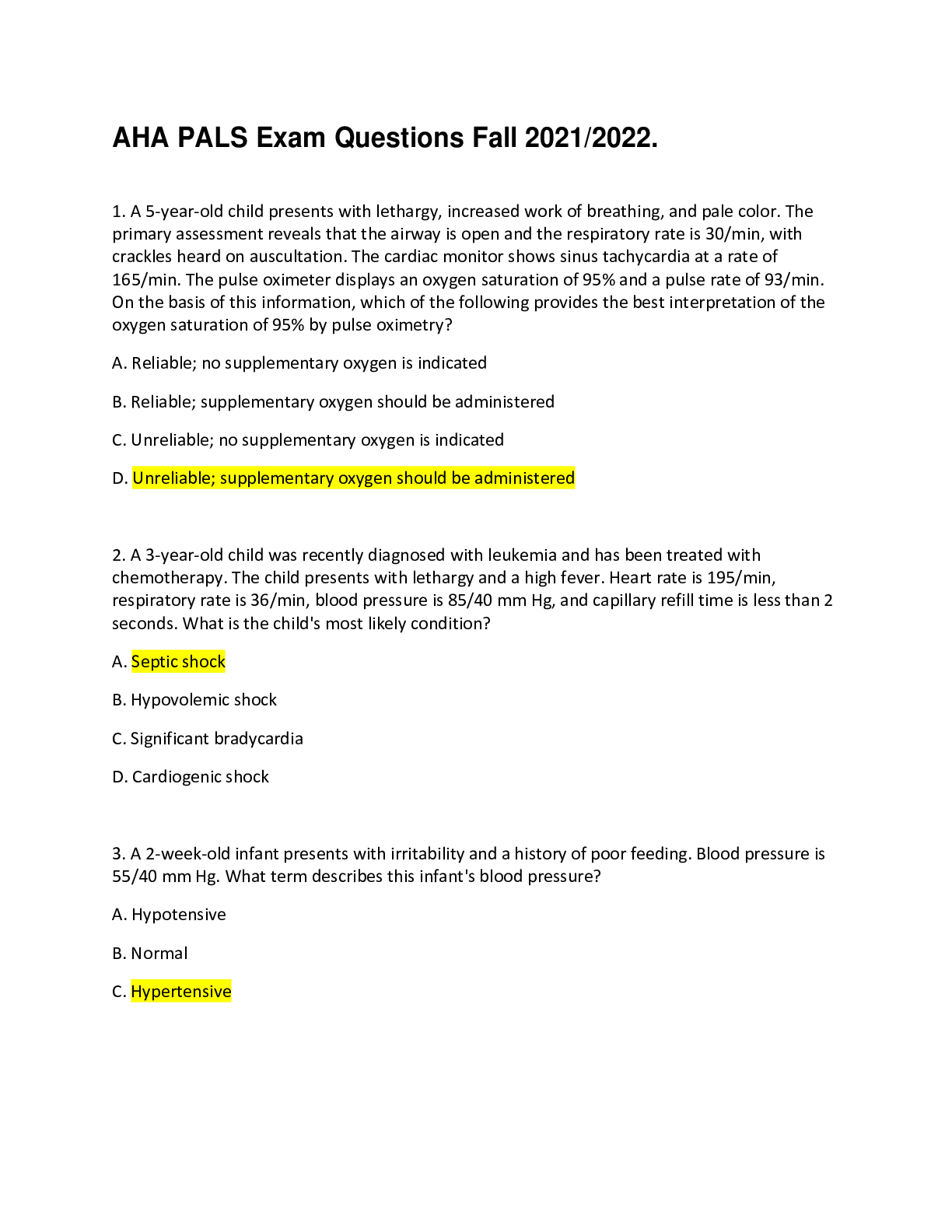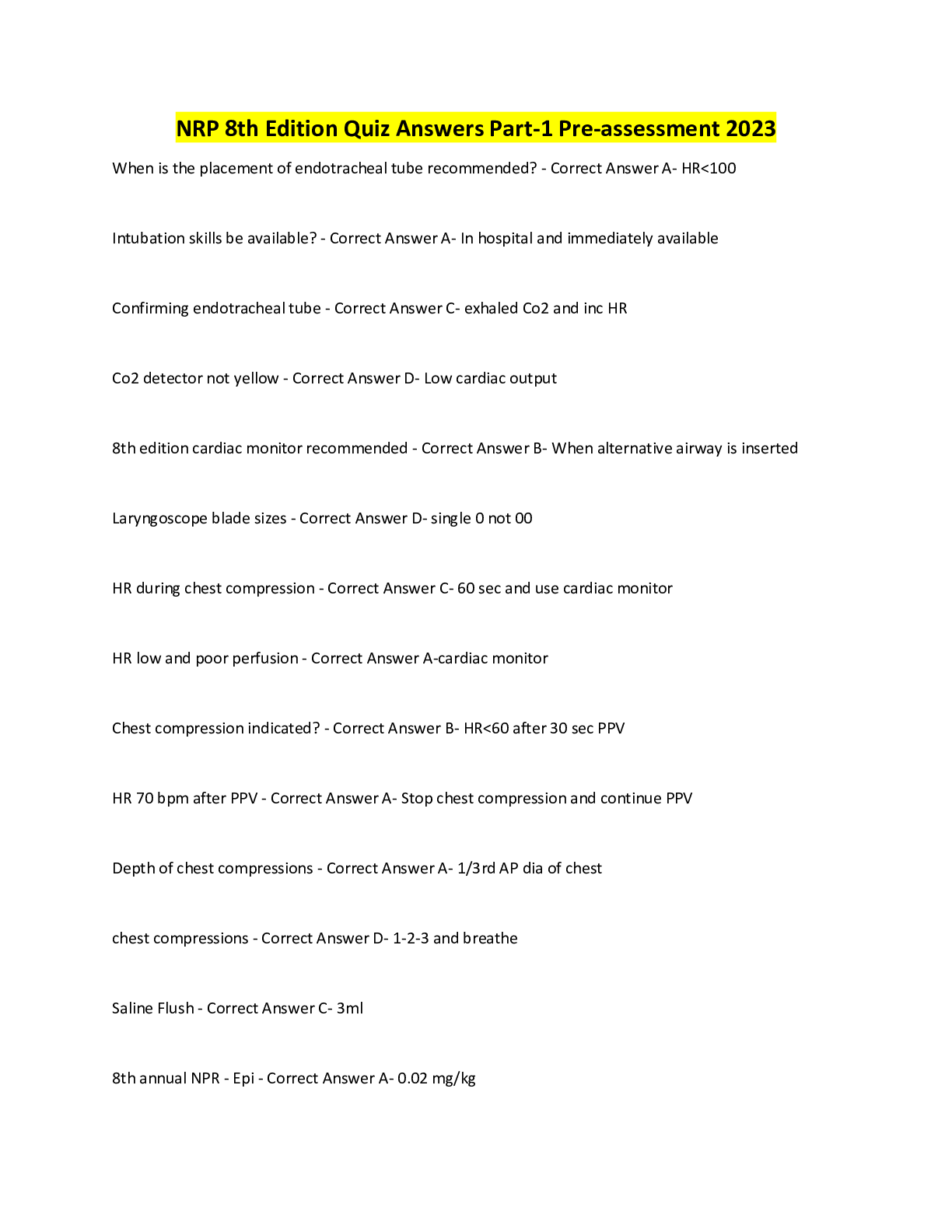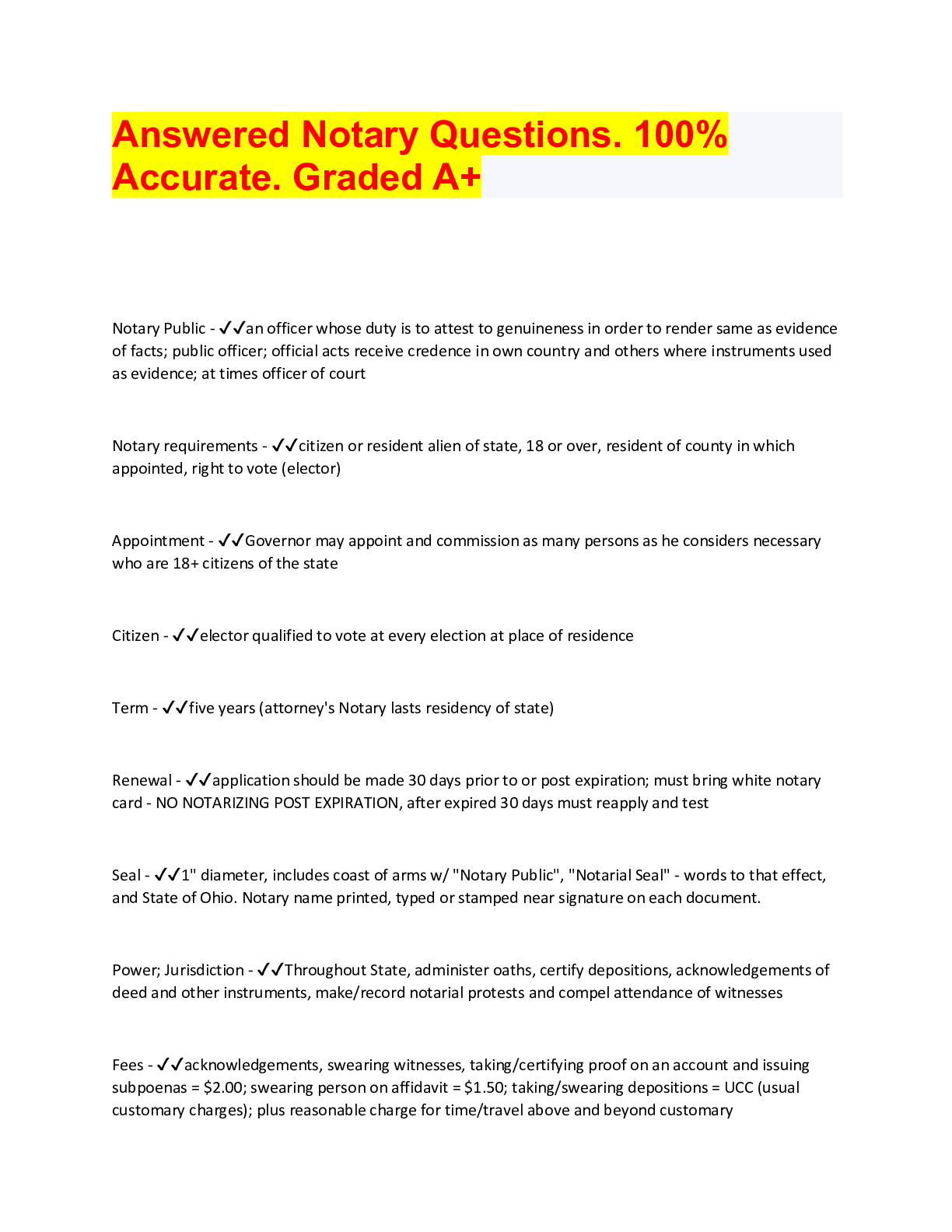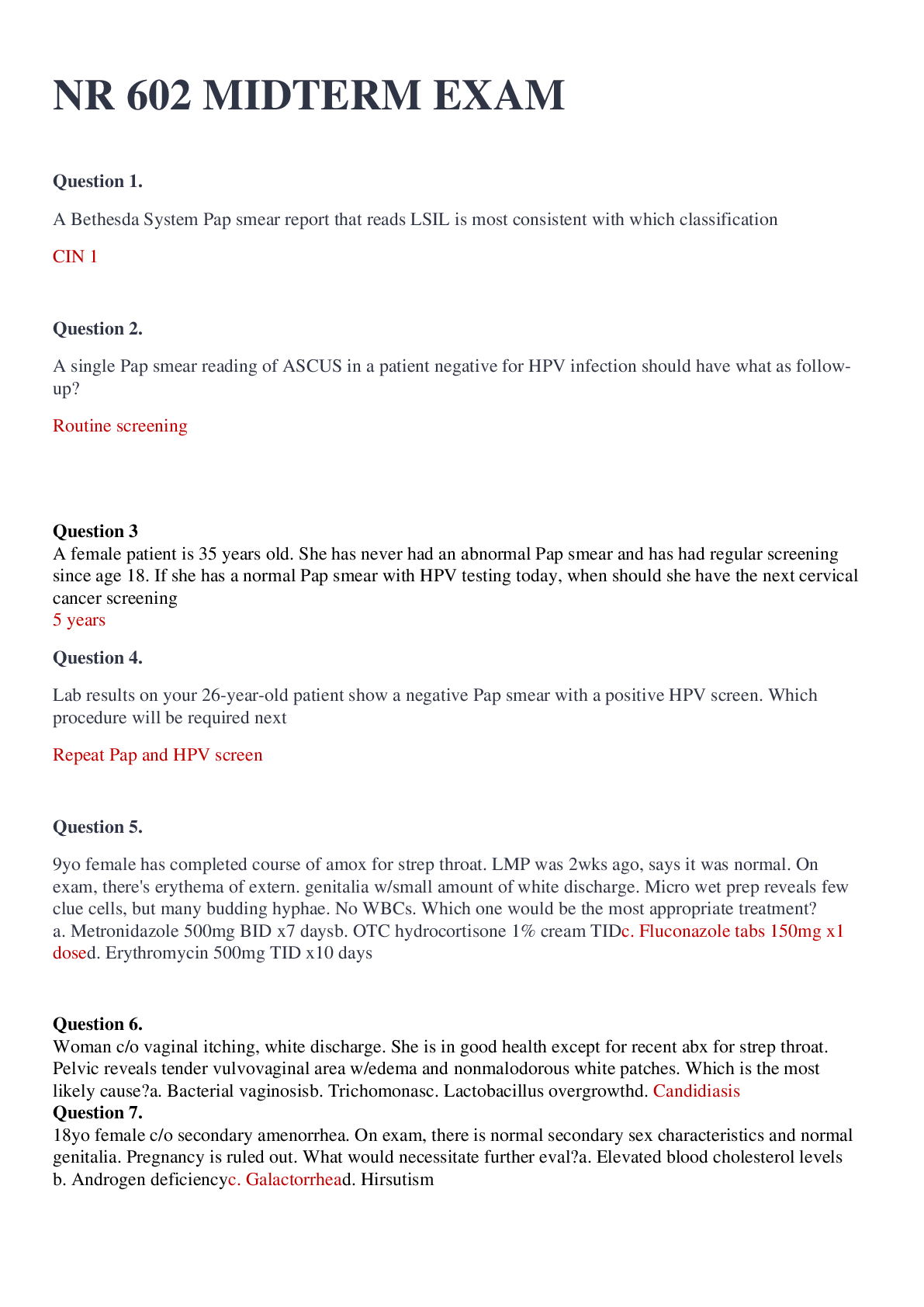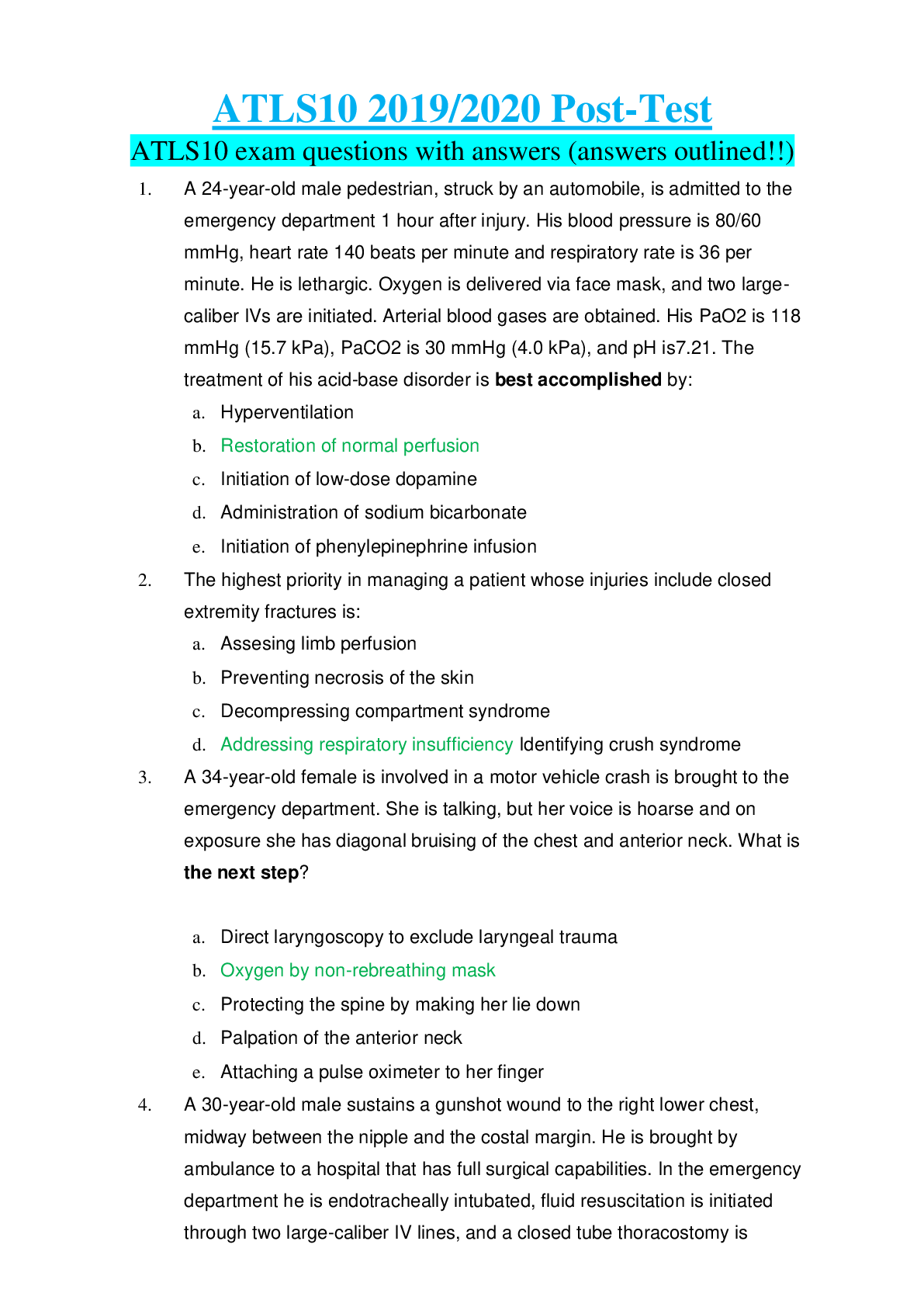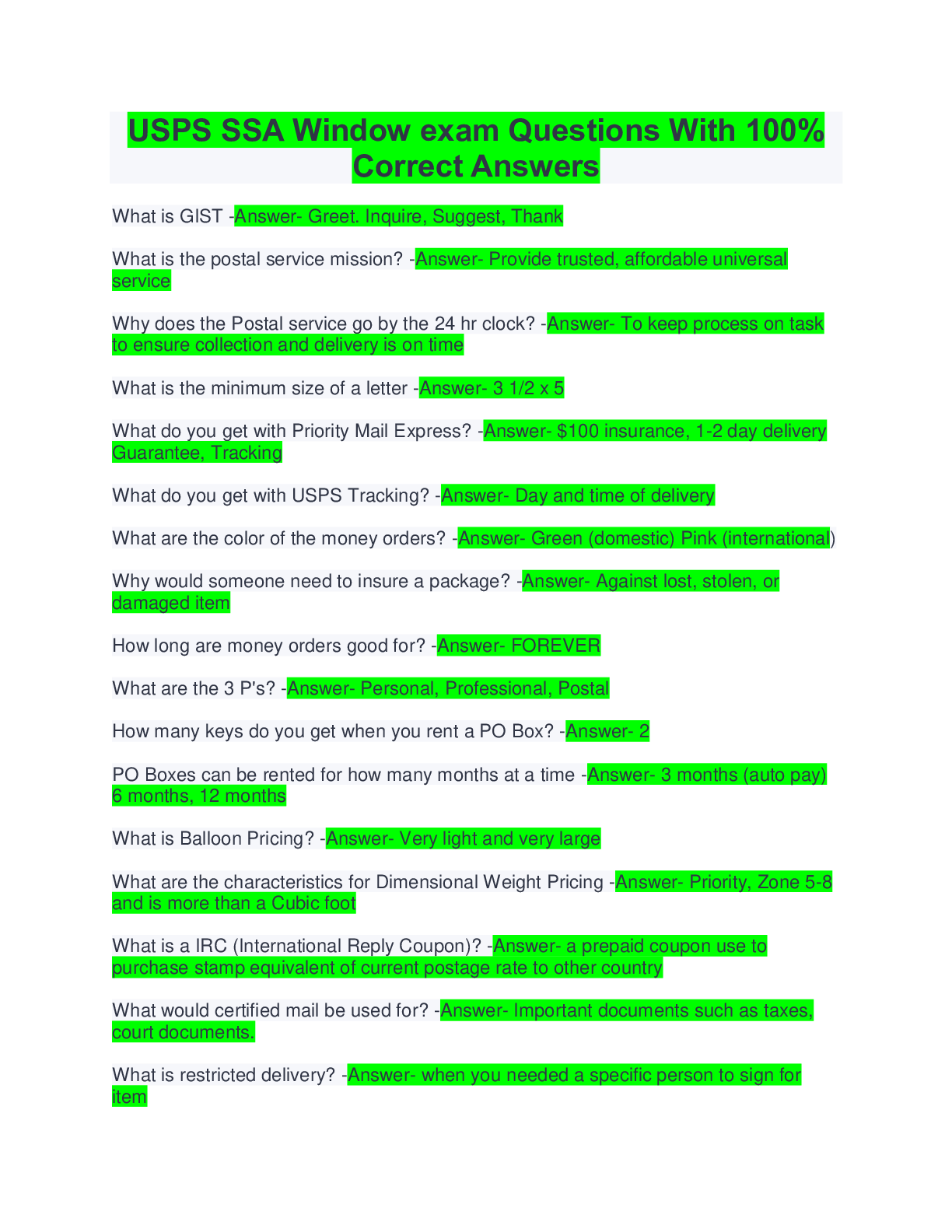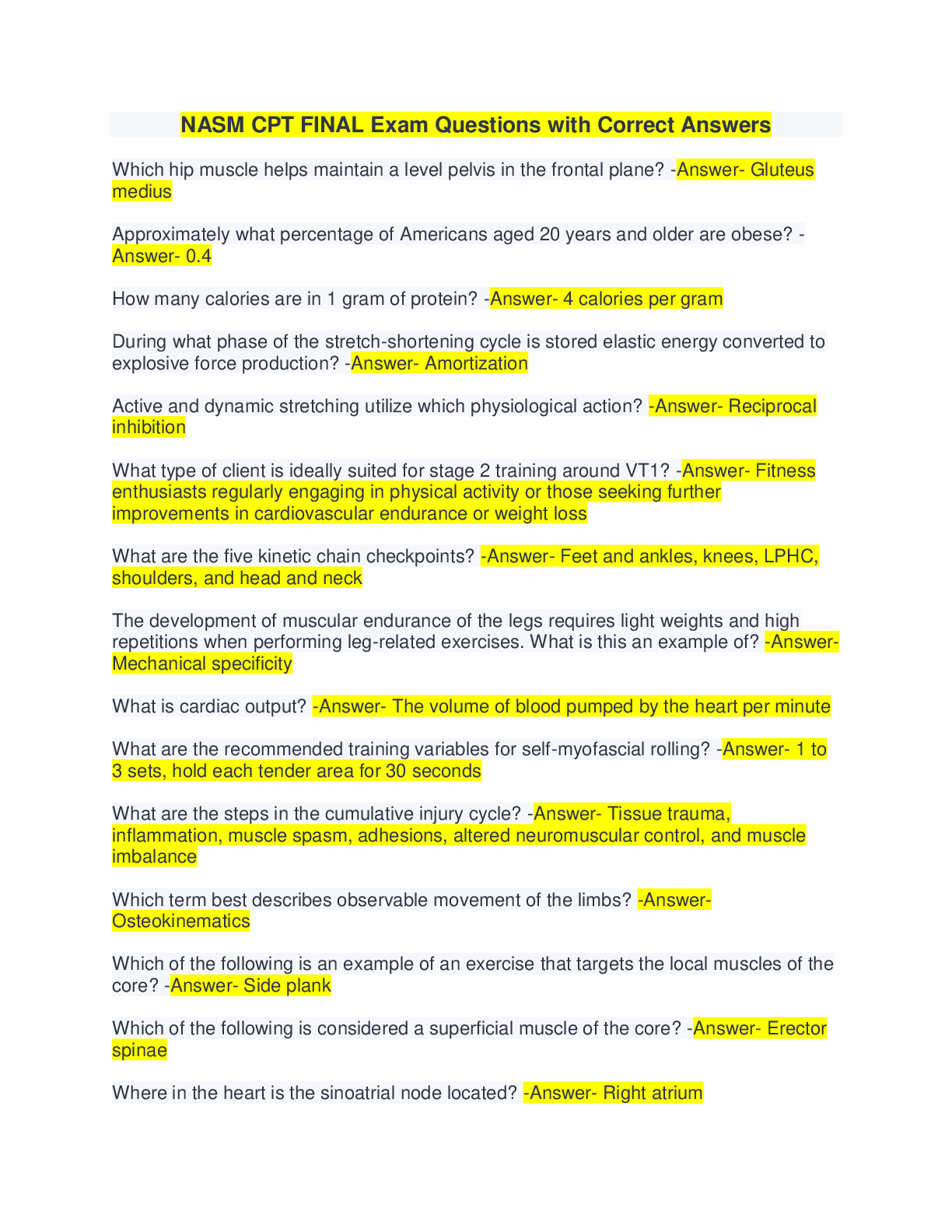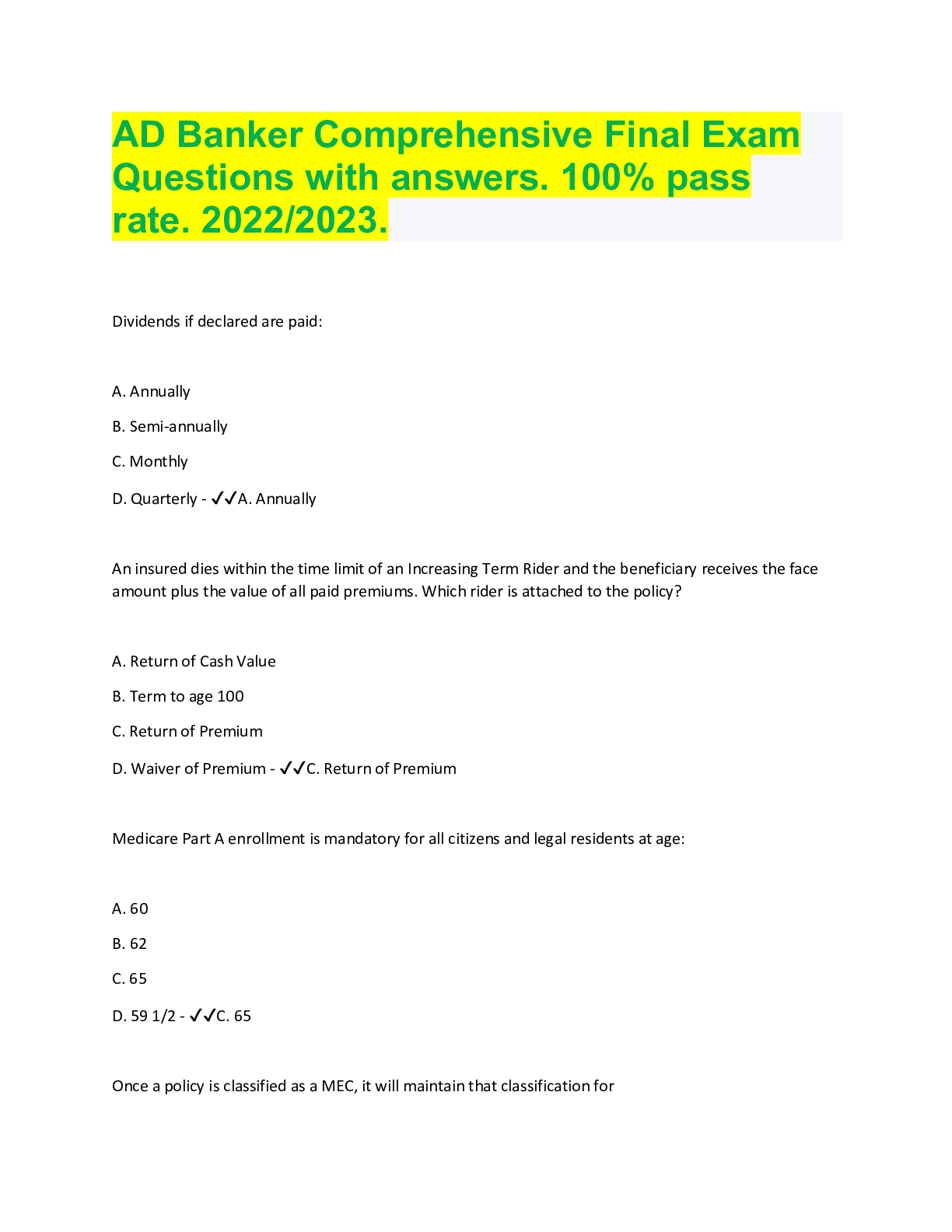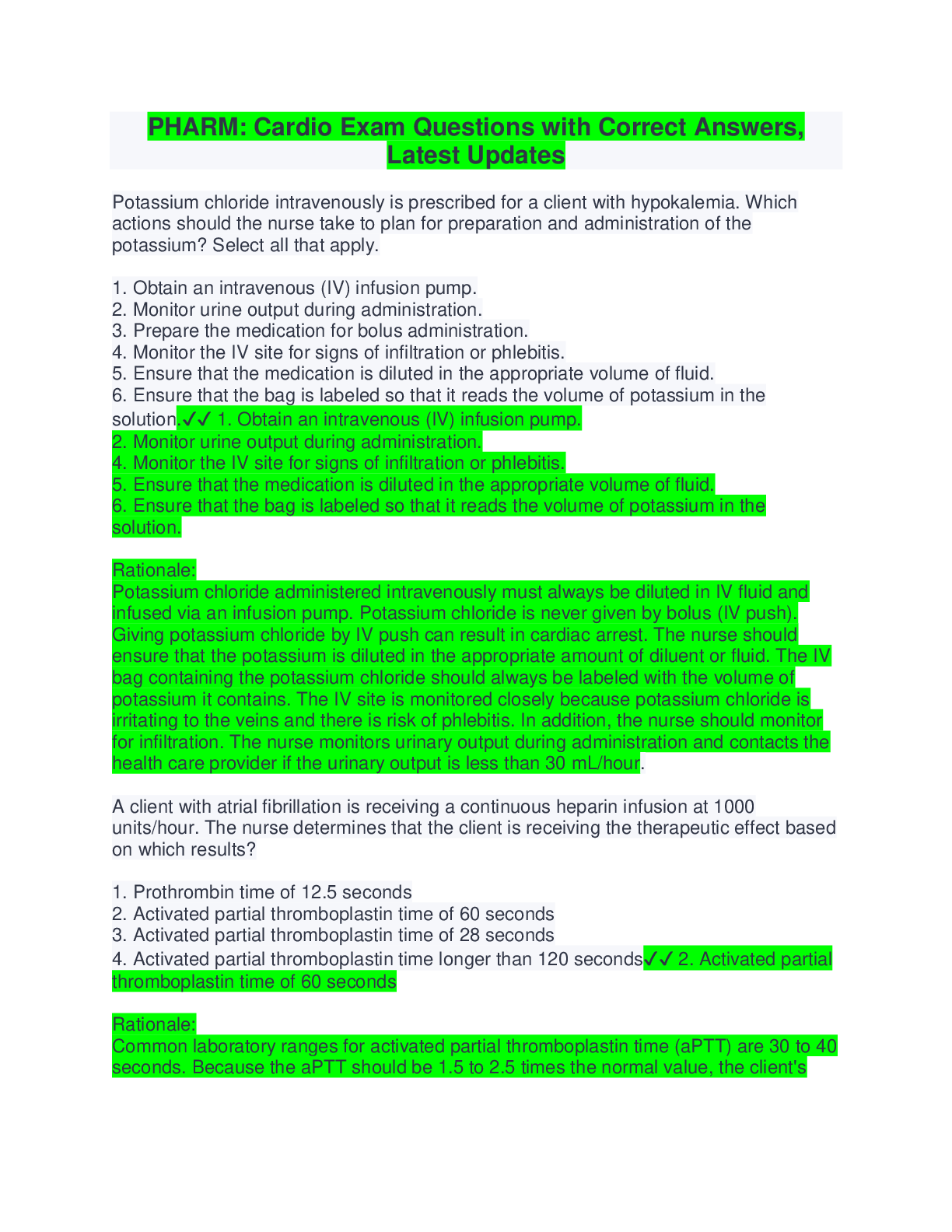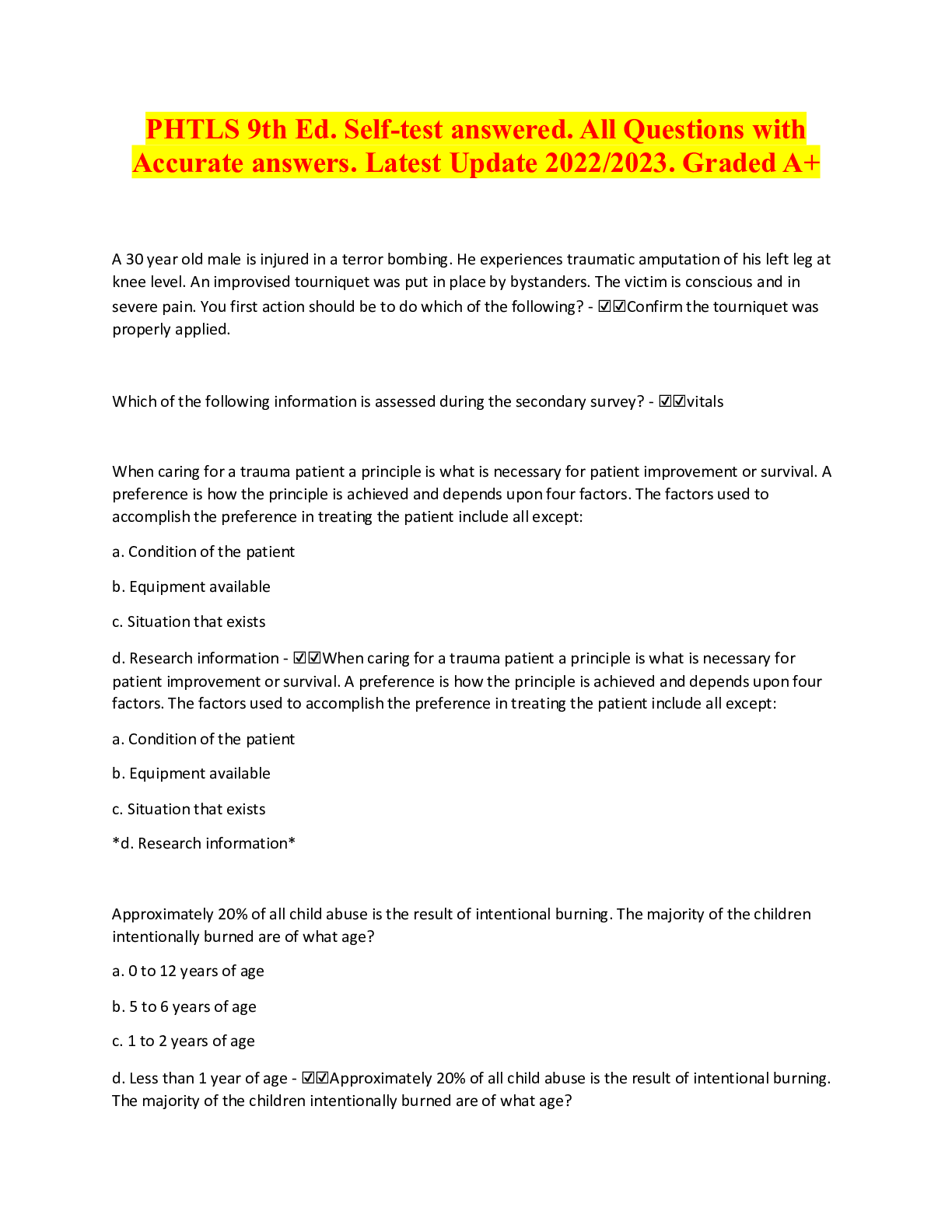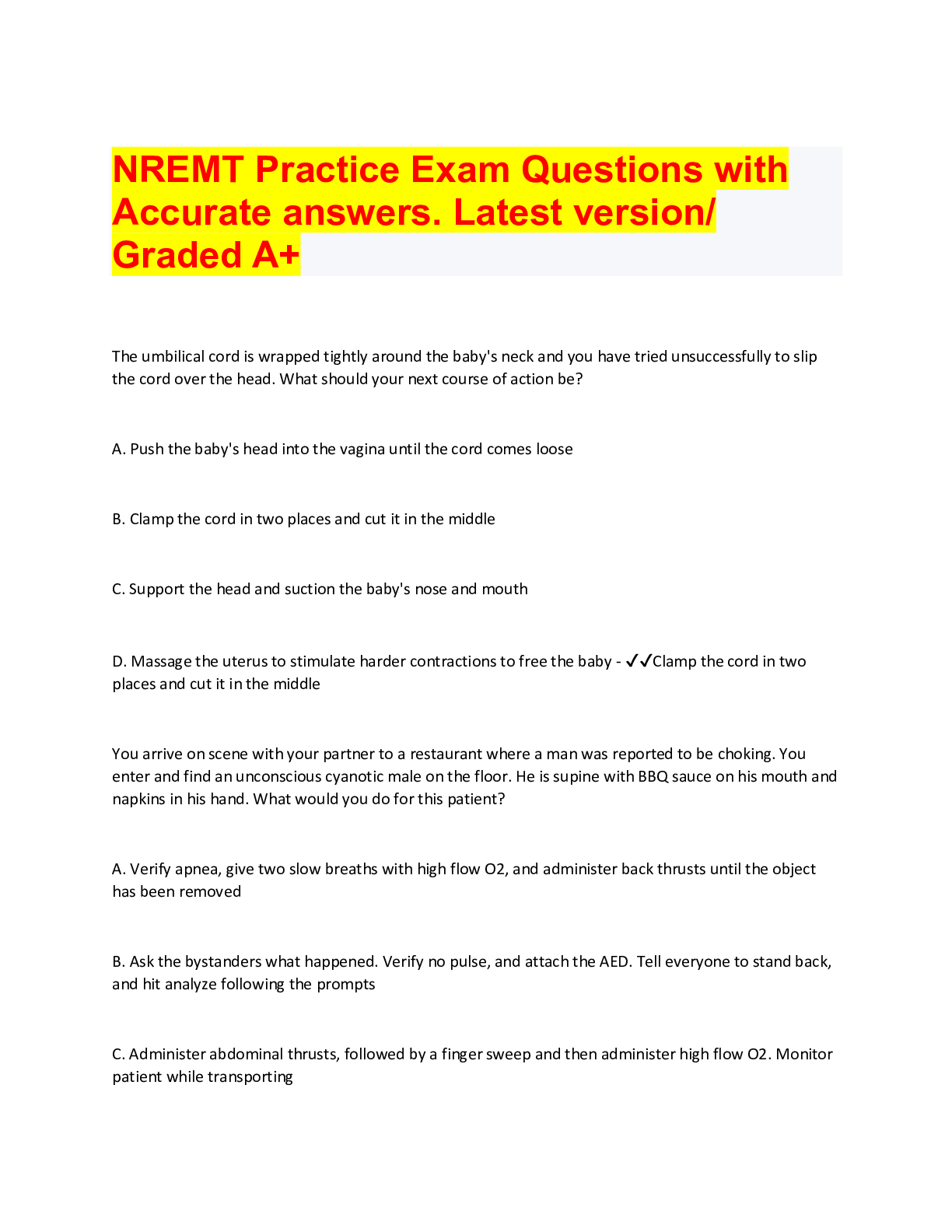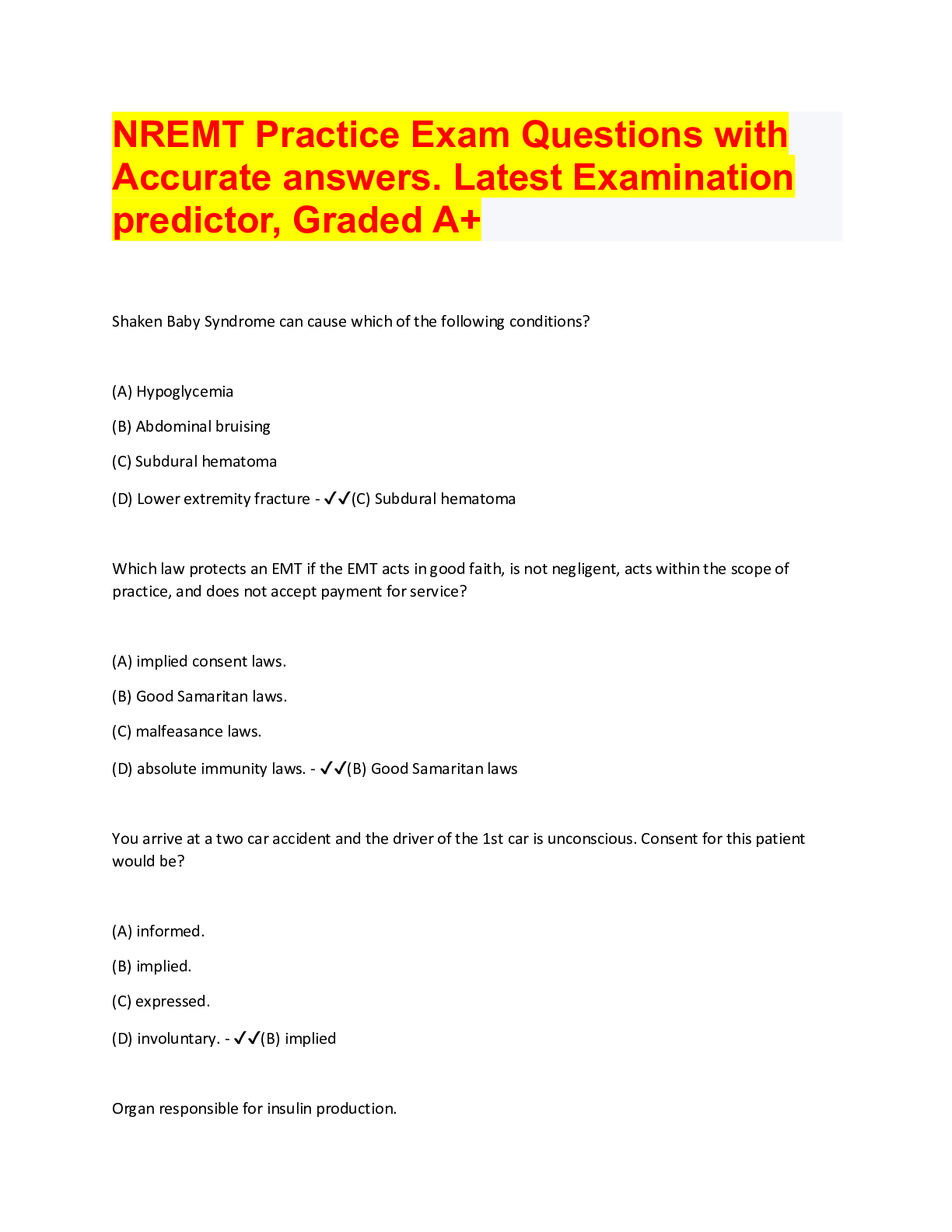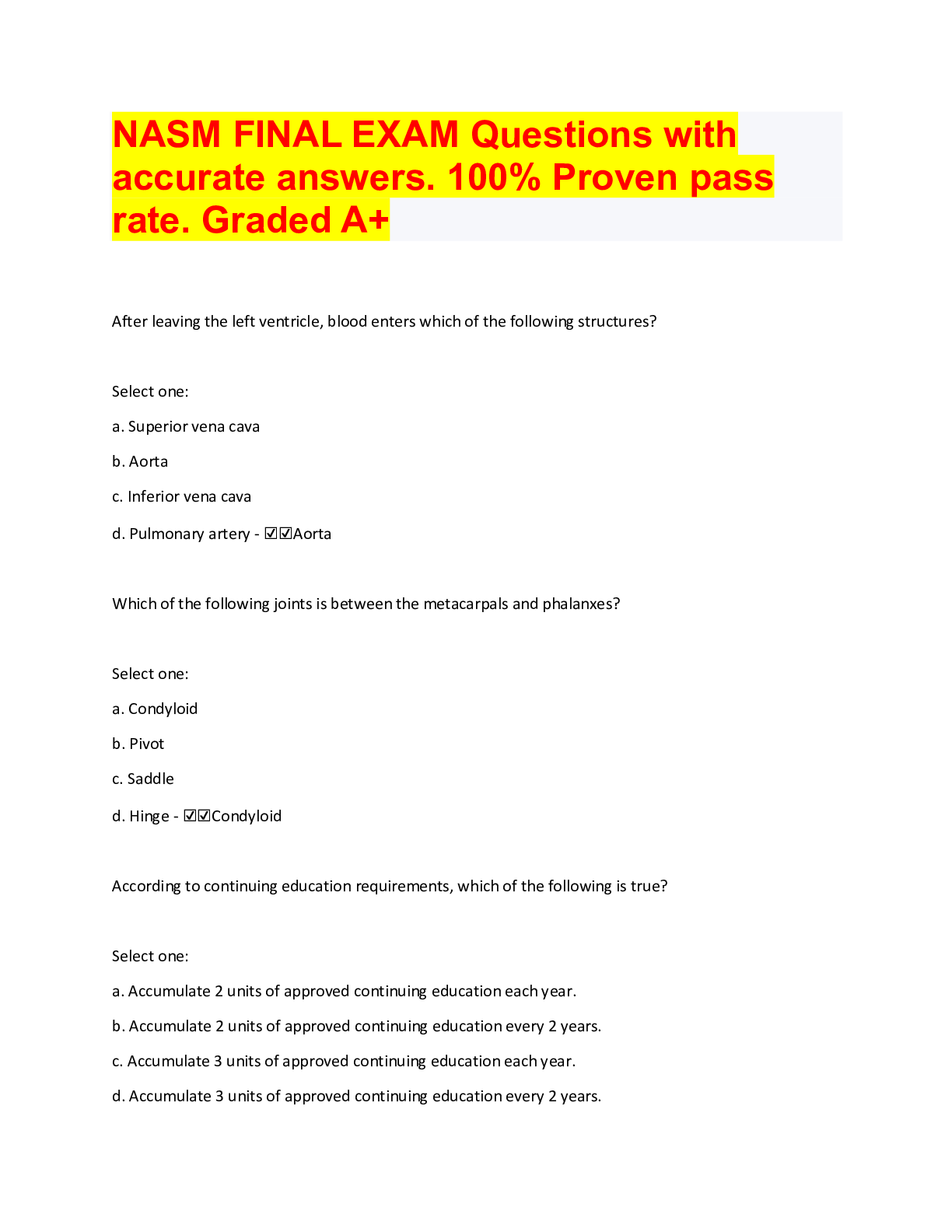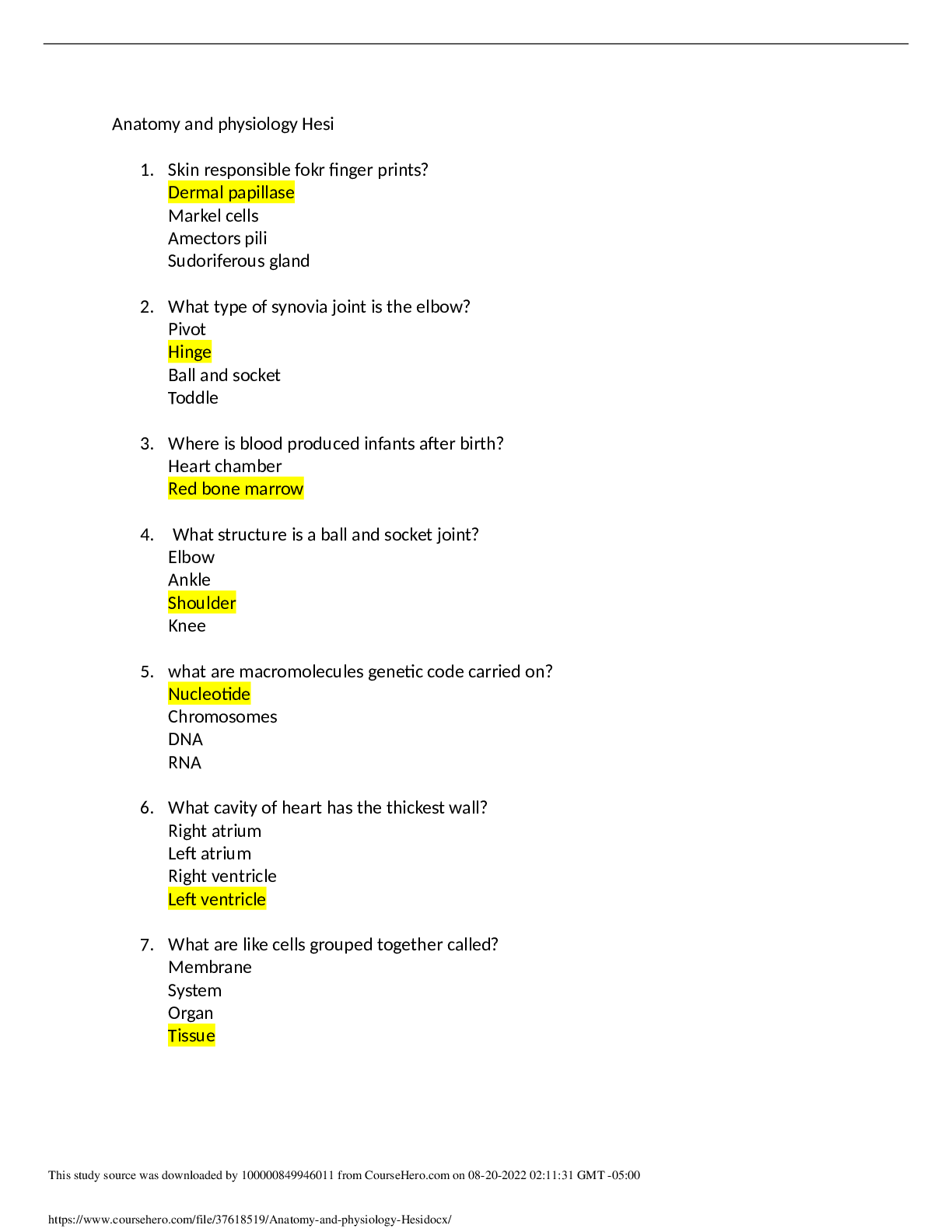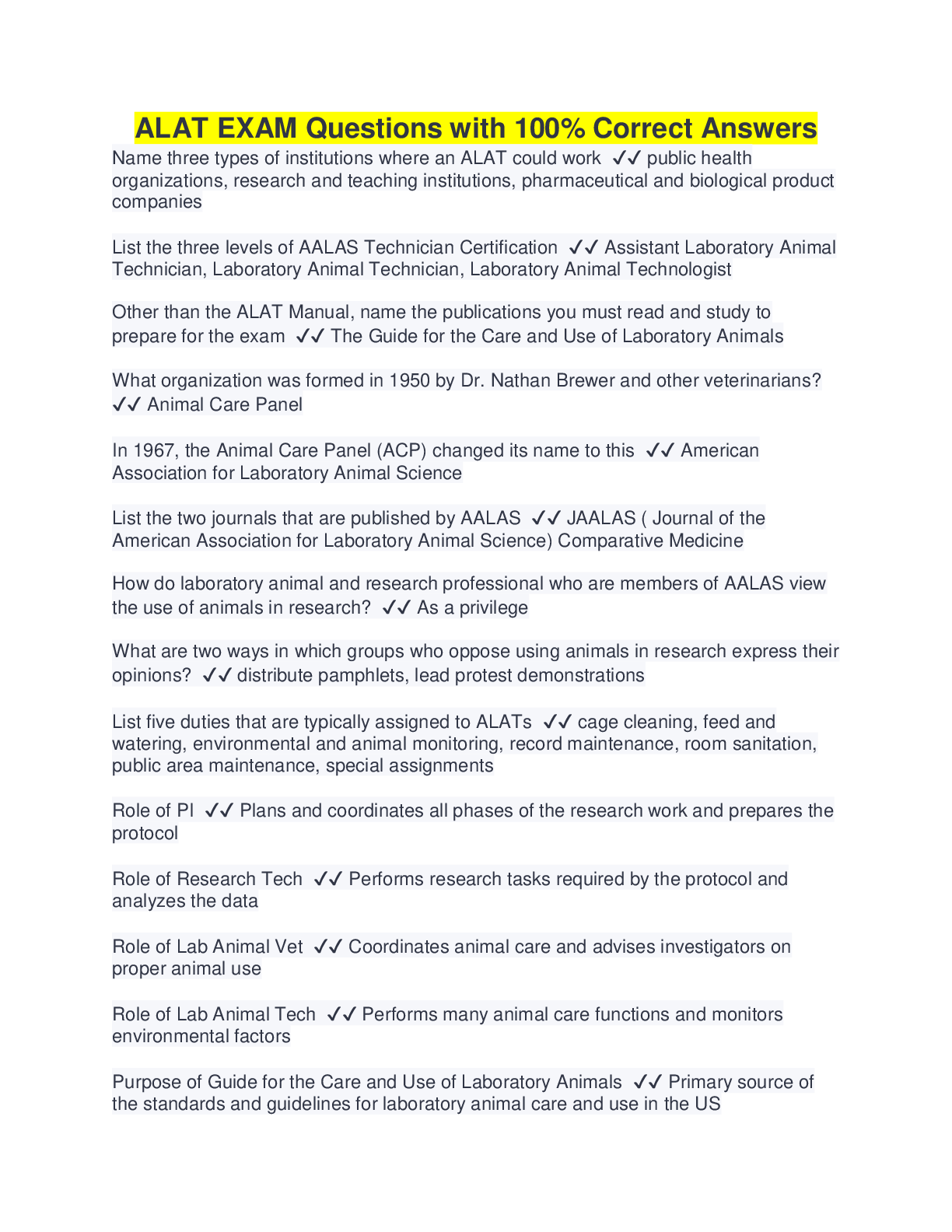Computer Science > QUESTIONS & ANSWERS > AZ 104 Exam Questions with 100% Correct Answers. 2022/2023. Graded A (All)
AZ 104 Exam Questions with 100% Correct Answers. 2022/2023. Graded A
Document Content and Description Below
AZ 104 Exam Questions with 100% Correct Answers You need to define a custom domain name for Azure AD to support the planned infrastructure. Which domain name should you use? A. ad.humongousinsuranc... e.com B. humongousinsurance.onmicrosoft.com C. humongousinsurance.local D. humongousinsurance.com >>> Answer: D Every Azure AD directory comes with an initial domain name in the form of domainname.onmicrosoft.com. The initial domain name cannot be changed of deleted, but you can add your corporate domain name to AAD as well. Adding custom domain names to Azure AD allows you to assign user names in the directory that are familiar to your users, such as '[email protected].' instead of 'alice@domain name.onmicrosoft.com'. You need to prepare the environment to meet the authentication requirements. Which two actions should you perform? Each correct answer presents part of the solution. NOTE: Each correct selection is worth one point. A. Allow inbound TCP port 8080 to the domain controllers in the Miami office. B. Add http://autogon.microsoftazuread-sso.com to the intranet zone of each client computer in the Miami office. C. Join the client computers in the Miami office to Azure AD. D. Install the Active Directory Federation Services (AD FS) role on a domain controller in the Miami Questions & Answers PDF P-16 www.dumpskey.com office. E. Install Azure AD Connect on a server in the Miami office and enable Pass-through Authentication. >>> Answer: BE B: You can gradually roll out Seamless SSO to your users. You start by adding the following Azure AD URL to all or selected users' Intranet zone settings by using Group Policy in Active Directory: https://autologon.microsoftazuread-sso.com E: Seamless SSO works with any method of cloud authentication - Password Hash Synchronization or Pass-through Authentication, and can be enabled via Azure AD Connect. Scenario: Licensing Issue 1. You attempt to assign a license in Azure to several users and receive the following error message: "Licenses not assigned. License agreement failed for one user."2. You verify that the Azure subscription has the available licenses. You need to resolve the licensing issue before you attempt to assign the license again. What should you do? A. From the Groups blade, invite the user accounts to a new group. B. From the Profile blade, modify the usage location. C. From the Directory role blade, modify the directory role. >>> Answer: B Explanation: Some Microsoft services aren't available in all locations because of local laws and regulations. Before you can assign a license to a user, you must specify the Usage location property for the user. You can specify the location under the User > Profile > Settings section in the Azure portal. You have an azure subscription named Subscription that contains the resource groups shown in the following table. RG1 - East Asia RG2 - East US In RG1, you create a virtual machine named VM1 in the East Asia location. You plan to create a virtual network named VNET1. You need to create VNET, and then connect VM1 to VNET1. What are two possible ways to achieve this goal? Each correct answer presents a complete a solution. NOTE: Each correct selection is worth one point. A. Create VNET1 in RG2, and then set East Asia as the location. B. Create VNET1 in a new resource group in the West US location, and then set West US as the location. C. Create VNET1 in RG1, and then set East Asia as the location D. Create VNET1 in RG1, and then set East US as the location. E. Create VNET1 in RG2, and then set East US as the location. >>> Answer: AC A network interface can exist in the same, or different resource group, than the virtual machine you attach it to, or the virtual network you connect it to. The virtual machine you attach a network interface to and the virtual network you connect it to must exist in the same location, also referred to as a region. Note, Resource groups can span multiple Regions, but VNets only can hold resources (VMs, Network Adapters) that exists in the same region. So in this scenario, you need to create VNET1 in any RG and set location as East Asia. You have an Azure subscription that contains a storage account named account1. You plan to upload the disk files of a virtual machine to account1 from your on-premises network. The on-premises network uses a public IP address space of 131.107.1.0/24. You plan to use the disk files to provision an Azure virtual machine named VM1. VM1 will be attached to a virtual network named VNet1. VNet1 uses an IP address space of 192.168.0.0/24. You need to configure account1 to meet the following requirements: Ensure that you can upload the disk files to account1. Ensure that you can attach thedisks to VM1. Prevent all other access to account1. Which two actions should you perform? Each correct selection presents part of the solution. NOTE: Each correct selection is worth one point. A. From the Firewalls and virtual networks blade of account1, add the 131.107.1.0/24 IP address range. B. From the Firewalls and virtual networks blade of account1, select Selected networks. C. From the Firewalls and virtual networks blade of acount1, add VNet1. D. From the Firewalls and virtual networks blade of account1, select Allow trusted Microsoft services to access this storage account. E. From the Service endpoints blade of VNet1, add a service endpoint. >>> Answer: AB By default, storage accounts accept connections from clients on any network. To limit access to selected networks, you must first change the default action. Azure portal 1. Navigate to the storage account you want to secure. 2. Click on the settings menu called Firewalls and virtual networks. 3. To deny access by default, choose to allow access from 'Selected networks'. To allow traffic from all networks, choose to allow access from 'All networks'. 4. Click Save to apply your changes. Grant access from a Virtual Network Storage accounts can be configured to allow access only from specific Azure Virtual Networks. By enabling a Service Endpoint for Azure Storage within the Virtual Network, traffic is ensured an optimal route to the Azure Storage service. The identities of the virtual network and the subnet are also transmitted with each request. You have an Azure Active Directory (Azure AD) tenant named contosocloud.onmicrosoft.com. Your company has a public DNS zone for contoso.com. You add contoso.com as a custom domain name to Azure AD. You need to ensure that Azure can verify the domain name. Which type of DNS record should you create? A. PTR B. MX C. NSEC3 D. RRSIG >>> Answer: B TXT or MX : Correct You can use either a TXT or MX record to verify the custom domain in the Azure AD. MX records can serve the purpose of TXT records Questions & Answers PDF P-56 www.dumpskey.com SRV : Incorrect SRV records are used by various services to specify server locations. When specifying an SRV record in Azure DNS DNSKEY : Incorrect Choice This will verify that the records are originating from an authorized sender. NSEC : Incorrect Choice This is Part of DNSSEC. This is used for explicit denial-of-existence of a DNS record. It is used to prove a name does not exist. You have an Azure virtual machine named VM1. Azure collects events from VM1. You are creating an alert rule in Azure Monitor to notify an administrator when an error islogged in the System event log of VM1. You need to specify which resource type to monitor. What should you specify? A. metric alert B. Azure Log Analytics workspace C. virtual machine D. virtual machine extension >>> Answer: B Explanation: Azure Monitor can collect data directly from your Azure virtual machines into a Log Analytics workspace for analysis of details and correlations. Installing the Log Analytics VM extension for Windows and Linux allows Azure Monitor to collect data from your Azure VMs. Azure Log Analytics workspace is also used for on-premises computers monitored by System Center Operations Manager. You have two Azure virtual machines named VM1 and VM2. You have two Recovery Services vaults named RSV1 and RSV2. VM2 is protected by RSV1. You need to use RSV2 to protect VM2. What should you do first? A. From the RSV1 blade, click Backup items and stop the VM2 backup. B. From the RSV1 blade, click Backup Jobs and export the VM2 backup. C. From the RSV1 blade, click Backup. From the Backup blade, select the backup for the virtual machine, and then click Backup. D. From the VM2 blade, click Disaster recovery, click Replication settings, and then select RSV2 as the Recovery Services vault >>> Answer: D The Azure Site Recovery service contributes to your disaster recovery strategy by managing and orchestrating replication, failover, and failback of on-premises machines and Azure virtual machines (VMs). You have an Azure subscription that contains a web app named webapp1. You need to add a custom domain named www.contoso.com to webapp1. What should you do first? A. Upload a certificate. B. Add a connection string. C. Stop webapp1. D. Create a DNS record. >>> Answer: B You create an App Service plan named App1 and an Azure web app named webapp1. You discover that the option to create a staging slot is unavailable. You need to create a staging slot for App1. What should you do first? A. From webapp1, modify the Application settings. B. From webapp1, add a custom domain. C. From App1, scale up the App Service plan. D. From App1, scale out the App Service plan. >>> Answer: CScale up: Get more CPU, memory, disk space, and extra features like dedicated virtual machines (VMs), custom domains and certificates, staging slots, autoscaling, and more. You scale up by changing the pricing tier of the App Service plan that your app belongs to. You download an Azure Resource Manager template based on an existing virtual machine. The template will be used to deploy 100 virtual machines. You need to modify the template to reference an administrative password. You must prevent the password from being stored in plain text. What should you create to store the password? Questions & Answers PDF P-73 www.dumpskey.com A. Azure Active Directory (AD) Identity Protection and an Azure policy B. a Recovery Services vault and a backup policy C. an Azure Key Vault and an access policy D. an Azure Storage account and an access policy >>> Answer: C Explanation: You can use a template that allows you to deploy a simple Windows VM by retrieving the password that is stored in a Key Vault. Therefore the password is never put in plain text in the template parameter file You plan to use the Azure Import/Export service to copy files to a storage account. Which two files should you create before you prepare the drives for the import job? Each correct answer presents part of the solution. NOTE: Each correct selection is worth one point. A. an XML manifest file B. a driveset CSV file C. a dataset CSV file D. a PowerShell PS1 file E. a JSON configuration file >>> Answer: BC Explanation: B: Modify the driveset.csv file in the root folder where the tool resides. C: Modify the dataset.csv file in the root folder where the tool resides. Depending on whether you want to import a file or folder or both, add entries in the dataset.csv file You have an Azure subscription named Subscription1. You have 5 TB of data that you need to transfer to Subscription1. You plan to use an Azure Import/Export job. What can you use as the destination of the imported data? A. Azure Data Lake Store B. a virtual machine C. the Azure File Sync Storage Sync Service D. Azure Blob storage >>> Answer: D Explanation: Azure Import/Export service is used to securely import large amounts of data to Azure Blob storage and Azure Files by shipping disk drives to an Azure datacenter. The maximum size of an Azure Files Resource of a file share is 5 TB.You have an Azure subscription that contains the following resources: 100 Azure virtual machines 20 Azure SQL databases 50 Azure file shares You need to create a daily backup of all the resources by using Azure Backup. What is the minimum number of backup policies that you must create? A. 1 B. 2 C. 3 D. 150 E. 170 >>> Answer: C Explanation: There is a limit of 100 VMs that can be associated to the same backup policy from portal. We recommend that for more than 100 VMs, create multiple backup policies with same schedule or different schedule. One policy for VMS, one for SQL databases, and one for the file shares. You have an Azure virtual machine named VM1. You use Azure Backup to create a backup of VM1 named Backup1. After creating Backup1, you perform the following changes to VM1: Modify the size of VM1. Copy a file named Budget.xls to a folder named Data. Reset the password for the built-in administrator account. Questions & Answers PDF P-110 www.dumpskey.com Add a data disk to VM1. An administrator uses the Replace existing option to restore VM1 from Backup1. You need to ensure that all the changes to VM1 are restored. Which change should you perform again? A. Modify the size of VM1. B. Add a data disk. C. Reset the password for the built-in administrator account. D. Copy Budget.xls to Data. >>> Answer: D The scenario mentioned in the question, we are using the replace option. So in this case we would lose the existing data written to the disk after the backup was taken. The file was copied to the disk after the backup was taken. Hence, we would need to copy the file once again. You have a Microsoft 365 tenant and an Azure Active Directory (Azure AD) tenant named contoso.com. You plan to grant three users named User1, User2, and User3 access to a temporary Microsoft SharePoint document library named Library1. You need to create groups for the users. The solution must ensure that the groups are deleted automatically after 180 days. Which two groups should you create? Each correct answer presents a complete solution. NOTE: Each correct selection is worth one point. A. a Security group that uses the Assigned membership type B. an Office 365 group that uses the Assigned membership type C. an Office 365 group that uses the Dynamic User membership type D. a Security group that uses the Dynamic User membership type E. a Security group that uses the Dynamic Device membership type >>> Answer: BCExplanation: You can set expiration policy only for Office 365 groups in Azure Active Directory (Azure AD). Note: With the increase in usage of Office 365 Groups, administrators and users need a way to clean up unused groups. Expiration policies can help remove inactive groups from the system and make things cleaner. When a group expires, all of its associated services (the mailbox, Planner, SharePoint site, etc.) are also deleted. You can set up a rule for dynamic membership on security groups or Office 365 groups. Incorrect Answers: A, D, E: You can set expiration policy only for Office 365 groups in Azure Active Directory (Azure AD). You have an Azure Active Directory (Azure AD) tenant named contoso.com. Multi-factor authentication (MFA) is enabled for all users. You need to provide users with the ability to bypass MFA for 10 days on devices to which they have successfully signed in by using MFA. What should you do? A. From the multi-factor authentication page, configure the users' settings. B. From Azure AD, create a conditional access policy. C. From the multi-factor authentication page, configure the service settings. D. From the MFA blade in Azure AD, configure the MFA Server settings >>> Answer: C Explanation: Enable remember Multi-Factor Authentication Sign in to the Azure portal. On the left, select Azure Active Directory > Users. Select Multi-Factor Authentication. Under Multi-Factor Authentication, select service settings. On the Service Settings page, manage remember multi-factor authentication, select the Allow users to remember multi-factor authentication on devices they trust option. Set the number of days to allow trusted devices to bypass two-step verification. The default is 14 days. Select Save. You have an Azure virtual machine named VM1 that runs Windows Server 2019. You sign in to VM1 as a user named User 1 and perform the following actions: * Create files on drive C. * Create files on drive 0. * Modify the screen saver timeout. * Change the desktop background. You plan to redeploy VM1. Which changes will be lost after you redeploy VM1? A. the modified screen saver timeout B. the new desktop background C. the new files on drive D. The new files on drive C >>> Answer: D Note: This question is part of a series of questions that present the same scenario. Each question in the series contains a unique solution that might meet the stated goals. Some question sets might have more than one correct solution, while others might not have a correct solution. After you answer a question in this section, you will NOT be able to return to it. As a result, these questions will not appear in the review screen. You have an Azure subscription that contains the following resources: A virtual network that has a subnet named Subnet1 Two network security groups (NSGs) named NSG-VM1and NSG-Subnet1 A virtual machine named VM1 that has the required Windows Server configurations to allow Remote Desktop connections NSG-Subnet1 has the default inbound security rules only. NSG-VM1 has the default inbound security rules and the following custom inbound security rule: Priority: 100 Source: Any Source port range: * Destination: * Destination port range: 3389 Protocol: UDP Action: Allow VM1 connects to Subnet1. NSG1-VM1 is associated to the network interface of VM1. NSG-Subnet1 is associated to Subnet1. You need to be able to establish Remote Desktop connections from the internet to VM1. Solution: You add an inbound security rule to NSG-Subnet1 that allows connections from the Internet source to the VirtualNetwork destination for port range 3389 and uses the UDP protocol. Does this meet the goal? A. Yes B. No >>> Answer: B The default port for RDP is TCP port 3389 not UDP. NSGs deny all inbound traffic except from virtual network or load balancers. For inbound traffic, Azure processes the rules in a network security group associated to a subnet first, and then the rules in a network security group associated to the network interface. By default NSG rule to allow traffic through RDP port 3389 is not created automatically during the creation of VM , unless you change the setting during creation. Here in the solution UDP traffic is allowed at virtual network level which is not tcp/rdp protocol. So this will not work to achieve the goal. You have an Azure subscription that contains an Azure Active Directory (Azure AD) tenant named adatum.com. The tenant contains 500 user accounts. You deploy Microsoft Office 365. You configure Office 365 to use the user accounts in adatum.com. You configure 60 users to connect to mailboxes in Microsoft Exchange Online. You need to ensure that the 60 users use Azure Multi-Factor Authentication (MFA) to connect to the Exchange Online mailboxes. The solution must only affect connections to the Exchange Online mailboxes. What should you do? A. From the multi-factor authentication page, configure the Multi-Factor Auth status for each user B. From Azure Active Directory admin center, create a conditional access policy C. From the multi-factor authentication page, modify the verification options D. From the Azure Active Directory admin center, configure an authentication method >>> Answer: A You have an Azure subscription that contains an Azure Active Directory (Azure AD) tenant named contoso.com and an Azure Kubernetes Service (AKS) cluster named AKS1. An administrator reports that she is unable to grant access to AKS1 to the users in contoso.com. You need to ensure that access to AKS1 can be granted to the contoso.com users. What should you do first? A. From contoso.com, modify the Organization relationships settings. B. From contoso.com, create an OAuth 2.0 authorization endpoint.C. Recreate AKS1. D. From AKS1, create a namespace. >>> Answer: B With Azure AD-integrated AKS clusters, you can grant users or groups access to Kubernetes resources within a namespace or across the cluster. To obtain a kubectl configuration context, a user can run the az aks get-credentials command. When a user then interacts with the AKS cluster with kubectl, they're prompted to sign in with their Azure AD credentials. This approach provides a single source for user account management and password credentials. The user can only access the resources as defined by the cluster administrator. Azure AD authentication is provided to AKS clusters with OpenID Connect. OpenID Connect is an identity layer built on top of the OAuth 2.0 protocol. For more information on OpenID Connect, see the Open ID connect documentation. From inside of the Kubernetes cluster, Webhook Token Authentication is used to verify authentication tokens. Webhook token authentication is configured and managed as part of the AKS cluster You have an Azure subscription named Subscription1 that contains an Azure Log Analytics workspace named Workspace1. You need to view the error events from a table named Event. Which query should you run in Workspace1? A. Event | where EventType is "error" B. Event | search "error" C. select * from Event where EventType == "error" D. Get-Event Event | where {$_.EventType -eq "error"} >>> Answer: B To search a term in a specific table, add in (table-name) just after the search operator You have an Azure virtual machine named VM1 that runs Windows Server 2019. You save VM1 as a template named Template1 to the Azure Resource Manager library. You plan to deploy a virtual machine named VM2 from Template1. What can you configure during the deployment of VM2? A. virtual machine size B. operating system C. administrator username D. resource group >>> Answer: D Explanation: When deploying a virtual machine from a template, you must specify: the Resource Group name and location for the VM the administrator username and password an unique DNS name for the public IP Note: This question is part of a series of questions that present the same scenario. Each question in the series contains a unique solution that might meet the stated goals. Some question sets might have more than one correct solution, while others might not have a correct solution. After you answer a question in this section, you will NOT be able to return to it. As a result, these questions will not appear in the review screen. Youhave an Azure virtual machine named VM1 that runs Windows Server 2016. You need to create an alert in Azure when more than two error events are logged to the System log on VM1 within an hour. Solution: You create an Azure Log Analytics workspace and configure the data settings. You add an extension to VM1. You create an alert in Azure Monitor and specify the Log Analytics workspace as the source. Does this meet the goal? A. Yes B. No >>> Answer: B Explanation: Instead: You create an Azure Log Analytics workspace and configure the data settings. You install the Microsoft Monitoring Agent on VM1. You create an alert in Azure Monitor and specify the Log Analytics workspace as the source You have an Azure Active Directory (Azure AD) domain that contains 5,000 user accounts. You create a new user account named AdminUser1. You need to assign the User administrator administrative role to AdminUser1. What should you do from the user account properties? A. From the Directory role blade, modify the directory role. B. From the Groups blade, invite the user account to a new group. C. From the Licenses blade, assign a new license. >>> Answer: A Explanation: Assign a role to a user Sign in to the Azure portal with an account that's a global admin or privileged role admin for the directory. Select Azure Active Directory, select Users, and then select a specific user from the list. For the selected user, select Directory role, select Add role, and then pick the appropriate admin roles from the Directory roles list, such as Conditional access administrator. Press Select to save. You have an Azure Active Directory (Azure AD) tenant named contoso.onmicrosoft.com that contains 100 user accounts. You purchase 10 Azure AD Premium P2 licenses for the tenant. You need to ensure that 10 users can use all the Azure AD Premium features. What should you do? A. From the Groups blade of each user, invite the users to a group. B. From the Licenses blade of Azure AD, assign a license. C. From the Directory role blade of each user, modify the directory role. D. From the Azure AD domain, add an enterprise application. >>> Answer: B Many Azure Active Directory (Azure AD) services require you to license each of your users or groups (and associated members) for that service. Only users with active licenses will be able to access and use the licensed Azure AD services for which that's true. Licenses are applied per tenant and do not transfer to other tenants. Not all Microsoft services are available in all locations. Before a license can be assigned to a group, you must specify the Usage location for all members. You can set this value in the Azure Active Directory > Users > Profile > Settings area in Azure AD. Any user whose usage location is not specified inherits the location of the Azure AD organization. You can add the licensing rights to users or to an entire group.You have an Azure subscription named Subscription 1 and an on-premises deployment of Microsoft System Center Service Manager Subscription! contains a virtual machine named VM1. You need to ensure that an alert is set in Service Manager when the amount of available memory on VM1 is below 10 percent. What should you do first? A. Create a notification. B. Create an automation runbook. C. Deploy the IT Service Management Connector (ITSM). D. Deploy a function app. >>> Answer: C Explanation: The IT Service Management Connector (ITSMC) allows you to connect Azure and a supported IT Service Management (ITSM) product/service, such as the Microsoft System Center Service Manager. With ITSMC, you can create work items in ITSM tool, based on your Azure alerts (metric alerts, Activity Log alerts and Log Analytics alerts). You have an on-premises server that contains a folder named D:\Folder1. You need to copy the contents of D:\Folder1 to the public container in an Azure Storage account named contoso data. Which command should you run? A. https://contosodata.blob.core.windows.net/public B. azcopy sync D:\folder1 https://contosodata.blob.core.windows.net/public --snapshot C. azcopy copy D:\folder1 https://contosodata.blob.core.windows.net/public --recursive D. az storage blob copy start-batch D:\Folder1 https:// contosodata.blob.core.windows.net/public >>> Answer: C Explanation: The azcopy copy command copies a directory (and all of the files in that directory) to a blob container. The result is a directory in the container by the same name. Incorrect Answers: B: The azcopy sync command replicates the source location to the destination location. However, the file is skipped if the last modified time in the destination is more recent. D: The az storage blob copy start-batch command copies multiple blobs to a blob container. You have an Azure Storage account named storage1. You plan to use AzCopy to copy data to storage1. You need to identify the storage services in storage1 to which you can copy the data. What should you identify? A. blob, file, table, and queue B. blob and file only C. file and table only D. file only E. blob, table, and queue only >>> Answer: B Explanation: AzCopy is a command-line utility that you can use to copy blobs or files to or from a storage account. Incorrect Answers: A, C, E: AzCopy does not support tableand queue storage services. D: AzCopy supports file storage services, as well as blob storage services. You have an Azure subscription that contains an Azure Storage account. You plan to create an Azure container instance named container1 that will use a Docker image namedImage1. Image1 contains a Microsoft SQL Server instance that requires persistent storage. You need to configure a storage service for Container1. What should you use? A. Azure Files B. Azure Blob storage C. Azure Queue storage D. Azure Table storage >>> Answer: A Explanation: Microsoft have Docker Volume Plugin for Azure file storage which provides exactly this and it is used for Azure file shares. Azure File Storage volume plugin is not limited to ease of container migration. It also allows a file share to be shared among multiple containers (even though they are on different hosts) to collaborate on workloads, share configuration or secrets of an application running on multiple hosts. Another use case is uploading metrics and diagnostics data such as logs from applications to a file share for further processing. You have an app named App1 that runs on two Azure virtual machines named VM1 and VM2. You plan to implement an Azure Availability Set for App1. The solution must ensure that App1 is available during planned maintenance of the hardware hosting VM1 and VM2. What should you include in the Availability Set? A. one update domain B. two fault domains C. one fault domain D. two update domains >>> Answer: D Explanation: Microsoft updates, which Microsoft refers to as planned maintenance events, sometimes require that VMs be rebooted to complete the update. To reduce the impact on VMs, the Azure fabric is divided into update domains to ensure that not all VMs are rebooted at the same time. Incorrect Answers: A: An update domain is a group of VMs and underlying physical hardware that can be rebooted at the same time. B, C: A fault domain shares common storage as well as a common power source and network switch. It is used to protect against unplanned system failure. Note: This question is part of a series of questions that present the same scenario. Each question in the series contains a unique solution that might meet the stated goals. Some question sets might have more than one correct solution, while others might not have a correct solution. After you answer a question in this section, you will NOT be able to return to it. As a result, these questions will not appear in the review screen. Youhave an Azure subscription named Subscription1. Subscription1 contains a resource group named RG1. RG1 contains resources that were deployed by using templates. You need to view the date and time when the resources were created in RG1. Solution: From the RG1 blade, you click Automation script. Does this meet the goal? A. Yes B. No >>> Answer: B Explanation: From the RG1 blade, click Deployments. You see a history of deployment for the resource group. Reference: https://docs.microsoft.com/en-us/azure/azureresource-manager/templates/template-tutorialcreate-first-template?tabs=azurepowershell Through activity logs, you can determine: § what operations were taken on the resources in your subscription § who started the operation § when the operation occurred § the status of the operation § the values of other properties that might help you research the operation 1. On the Azure portal menu, select Monitor, or search for and select Monitor from any page 2. Select Activity Log. 3. You see a summary of recent operations. A default set of filters is applied to the operations. Notice the information on the summary includes who started the action and when it happened Note: This question is part of a series of questions that present the same scenario. Each question in the series contains a unique solution that might meet the stated goals. Some question sets might have more than one correct solution, while others might not have a correct solution. After you answer a question in this section, you will NOT be able to return to it. As a result, these questions will not appear in the review screen. You have an Azure subscription named Subscription1. Subscription1 contains a resource group named RG1. RG1 contains resources that were deployed by using templates. You need to view the date and time when the resources were created in RG1. Solution: From the RG1 blade, you click Deployments. Does this meet the goal? A. Yes B. No >>> Answer: A Explanation: 1. Select the resource group (Here RG1) you want to examine. 2. Select the link under Deployments. 3. Select one of the deployments from the deployment history. 4. You will see a history of deployment for the resource group, including the correlation ID. You have an Azure subscription named Subscription1. You deploy a Linux virtual machine named VM1 to Subscription1. You need to monitor the metrics and the logs of VM1. What should you use? A. Linux Diagnostic Extension (LAD) 3.0B. Azure Analysis Services C. the AzurePerformanceDiagnostics extension D. Azure HDInsight >>> Answer: A You can use extensions to configure diagnostics on your VMs to collect additional metric data. The basic host metrics are available, but to see more granular and VMspecific metrics, you need to install the Azure diagnostics extension on the VM. The Azure diagnostics extension allows additional monitoring and diagnostics data to be retrieved from the VM. You plan to deploy three Azure virtual machines named VM1, VM2, and VM3. The virtual machines will host a web app named App1. You need to ensure that at least two virtual machines are available if a single Azure datacenter becomes unavailable. What should you deploy? A. all three virtual machines in a single Availability Zone B. all virtual machines in a single Availability Set C. each virtual machine in a separate Availability Zone D. each virtual machine in a separate Availability Set >>> Answer: B Explanation: Availability sets are a datacenter configuration to provide VM redundancy and availability. This configuration within a datacenter ensures that during either a planned or unplanned maintenance event, at least one virtual machine is available. You have an Azure subscription that contains an Azure virtual machine named VM1. VM1 runs a financial reporting app named App1 that does not support multiple active instances. At the end of each month, CPU usage for VM1 peaks when App1 runs. You need to create a scheduled runbook to increase the processor performance of VM1 at the end of each month. What task should you include in the runbook? A. Add the Azure Performance Diagnostics agent to VM1. B. Modify the VM size property of VM1. C. Add VM1 to a scale set. D. Increase the vCPU quota for the subscription. E. Add a Desired State Configuration (DSC) extension to VM1. >>> Answer: B If you have a CPU/performance issue then the solution is to scale up (increase VM size) or to scale out (scale set) given that the App does not support multiple instances then scale up is the obvious choice. You recently created a new Azure subscription that contains a user named Admin1. Admin1 attempts to deploy an Azure Marketplace resource by using an Azure Resource Manager template. Admin1 deploys the template by using Azure PowerShell and receives the following error message: "User failed validation to purchase resources. Error message: "Legal terms have not been accepted for this item on this subscription. To accept legal terms, please go to the Azure portal(http://go.microsoft.com/fwlink/?LinkId=534873) and configure programmatic deployment for the Marketplace item or create it there for the first time." You need to ensure that Admin1 can deploy the Marketplace resource successfully. What should you do? A. From Azure PowerShell, run the Set-AzApiManagementSubscription cmdlet B. From the Azure portal, register the Microsoft.Marketplace resource provider C. From Azure PowerShell, run the Set-AzMarketplaceTerms cmdlet D. From the Azure portal, assign the Billing administrator role to Admin1 >>> Answer: C The Set-AzMarketplaceTerms cmdlet saves the terms object for given publisher id(Publisher), offer id(Product) and plan id(Name) tuple. You have an Azure virtual machine named VM1 that runs Windows Server 2019. You sign in to VM1 as a user named User 1 and perform the following actions: * Create files on drive C. * Create files on drive D. * Modify the screen saver timeout. * Change the desktop background. You plan to redeploy VM1. Which changes will be lost after you redeploy VM1? A. the modified screen saver timeout B. the new desktop background C. the new files on drive D D. The new files on drive C >>> Answer: C As D drive is temporary storage so new files on D drive will be lost. The screensaver, wall paper, new files on C drive are available after Redeploy. Note: This question is part of a series of questions that present the same scenario. Each question in the series contains a unique solution that might meet the stated goals. Some question sets might have more than one correct solution, while others might not have a correct solution. After you answer a question in this section, you will NOT be able to return to it. As a result, these questions will not appear in the review screen. You have an Azure subscription that contains 10 virtual networks. The virtual networks are hosted in separate resource groups. Another administrator plans to create several network security groups (NSGs) in the subscription. You need to ensure that when an NSG is created, it automatically blocks TCP port 8080 between the virtual networks. Solution: From the Resource providers blade, you unregister the Microsoft.ClassicNetwork provider. Does this meet the goal? A. Yes B. No >>> Answer: B Explanation: You should use a policy definition.Note: This question is part of a series of questions that present the same scenario. Each question in the series contains a unique solution that might meet the stated goals. Some question sets might have more than one correct solution, while others might not have a correct solution. After you answer a question in this section, you will NOT be able to return to it. As a result, these questions will not appear in the review screen. You have an Azure subscription that contains 10 virtual networks. The virtual networks are hosted in separate resource groups. Another administrator plans to create several network security groups (NSGs) in the subscription. You need to ensure that when an NSG is created, it automatically blocks TCP port 8080 between the virtual networks. Solution: You configure a custom policy definition, and then you assign the policy to the subscription. Does this meet the goal? A. Yes B. No >>> Answer: A Explanation: Resource policy definition used by Azure Policy enables you to establish conventions for resources in your organization by describing when the policy is enforced and what effect to take. By defining conventions, you can control costs and more easily manage your resources. Note: This question is part of a series of questions that present the same scenario. Each question in the series contains a unique solution that might meet the stated goals. Some question sets might have more than one correct solution, while others might not have a correct solution. After you answer a question in this section, you will NOT be able to return to it. As a result, these questions will not appear in the review screen. You have an Azure subscription that contains 10 virtual networks. The virtual networks are hosted in separate resource groups. Another administrator plans to create several network security groups (NSGs) in the subscription. You need to ensure that when an NSG is created, it automatically blocks TCP port 8080 between the virtual networks. Solution: You create a resource lock, and then you assign the lock to the subscription. Does this meet the goal? A. Yes B. No >>> Answer: B Explanation: How can I freeze or lock my production/critical Azure resources from accidental deletion? There is way to do this with both ASM and ARM resources using Azure resource lock. Note: This question is part of a series of questions that present the same scenario. Each question in the series contains a unique solution that might meet the stated goals. Some question sets might have more than one correct solution, while others might not have a correct solution. After you answer a question in this section, you will NOT be able to return to it. As a result, these questions will not appear in the review screen. You have an Azure subscription that contains 10 virtual networks. The virtual networks are hosted in separate resource groups. Another administrator plans to create severalnetwork security groups (NSGs) in the subscription. You need to ensure that when an NSG is created, it automatically blocks TCP port 8080 between the virtual networks. Solution: You assign a built-in policy definition to the subscription. Does this meet the goal? A. Yes B. No >>> Answer: B Explanation: Resource policy definition used by Azure Policy enables you to establish conventions for resources in your organization by describing when the policy is enforced and what effect to take. However, there are no built-in policy definitions. Though there are sample policy defintions. You have two Azure virtual networks named VNet1 and VNet2. VNet1 contains an Azure virtual machine named VM1. VNet2 contains an Azure virtual machine named VM2. VM1 hosts a frontend application that connects to VM2 to retrieve data. Users report that the frontend application is slower than usual. You need to view the average round-trip time (RTT) of the packets from VM1 to VM2. Which Azure Network Watcher feature should you use? A. NSG flow logs B. Connection troubleshoot C. IP flow verify D. Connection monitor >>> Answer: D Explanation: The Connection Monitor feature in Azure Network Watcher is now generally available in all public regions. Connection Monitor provides you RTT values on a per-minute granularity. You can monitor a direct TCP connection from a virtual machine to a virtual machine, FQDN, URI, or IPv4 address. You have an Azure subscription that contains a policy-based virtual network gateway named GW1 and a virtual network named VNet1. You need to ensure that you can configure a point-to-site connection from an on-premises computer to VNet1. Which two actions should you perform? Each correct answer presents part of the solution. NOTE: Each correct selection is worth one point. A. Add a service endpoint to VNet1 B. Reset GW1 C. Create a route-based virtual network gateway D. Add a connection to GW1 E. Delete GW1 F. Add a public IP address space to VNet1 >>> Answer: CE C: A VPN gateway is used when creating a VPN connection to your on-premises network. Route-based VPN devices use any-to-any (wildcard) traffic selectors, and let routing/forwarding tables direct traffic to different IPsec tunnels. It is typically built on router platforms where each IPsec tunnel is modeled as a network interface or VTI(virtual tunnel interface). E: Policy-based VPN devices use the combinations of prefixes from both networks to define how traffic is encrypted/decrypted through IPsec tunnels. It is typically built on firewall devices that perform packet filtering. IPsec tunnel encryption and decryption are added to the packet filtering and processing engine You have five Azure virtual machines that run Windows Server 2016. The virtual machines are configured as web servers. You have an Azure load balancer named LB1 that provides load balancing services for the virtual machines. You need to ensure that visitors are serviced by the same web server for each request. What should you configure? A. Floating IP (direct server return) to Enabled B. Idle Time-out (minutes) to 20 C. Protocol to UDP D. Session persistence to Client IP and Protocol >>> Answer: D With Sticky Sessions when a client starts a session on one of your web servers, session stays on that specific server. To configure An Azure Load-Balancer For Sticky Sessions set Session persistence to Client IP or to Client IP and protocol. O [Show More]
Last updated: 1 year ago
Preview 1 out of 58 pages
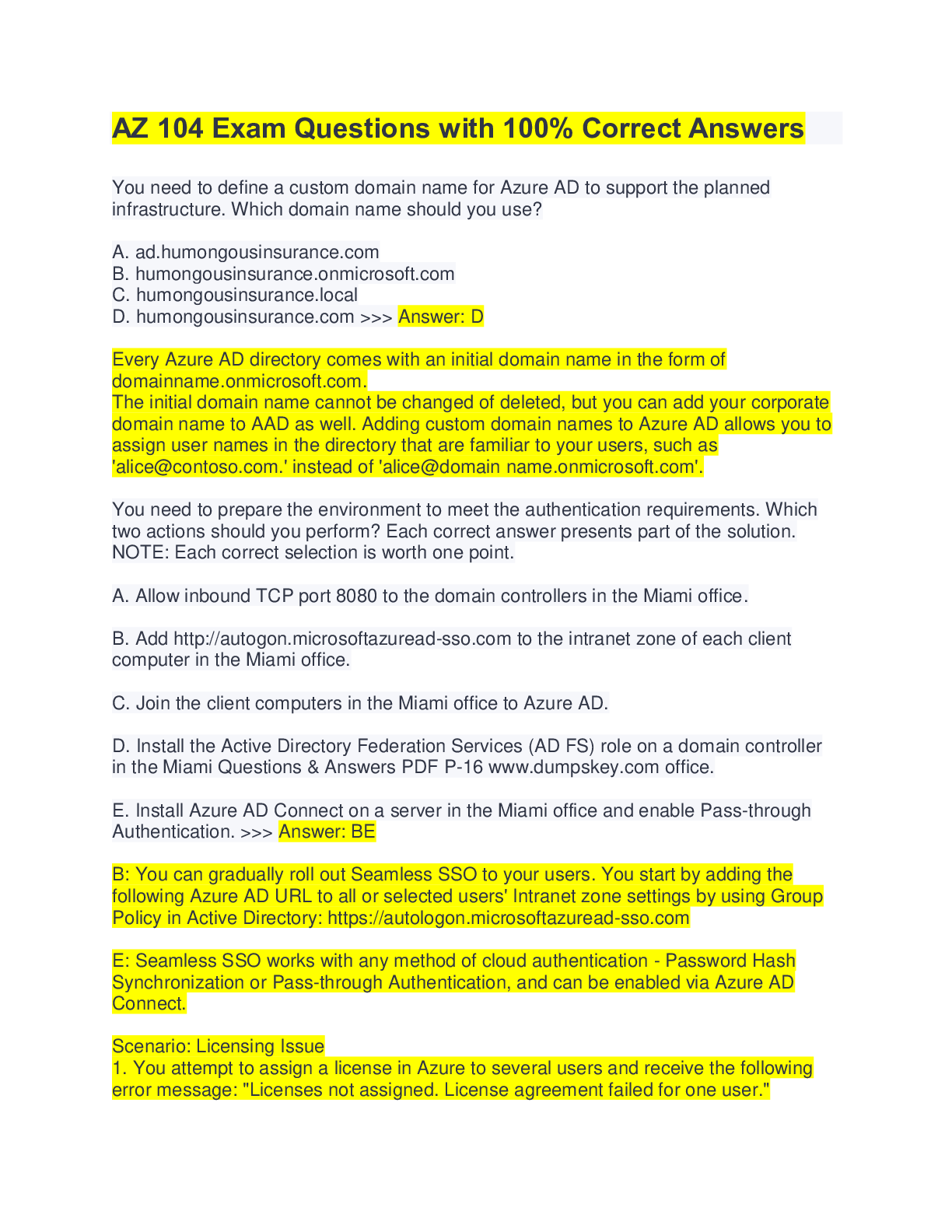
Reviews( 0 )
Document information
Connected school, study & course
About the document
Uploaded On
Sep 21, 2022
Number of pages
58
Written in
Additional information
This document has been written for:
Uploaded
Sep 21, 2022
Downloads
0
Views
264

